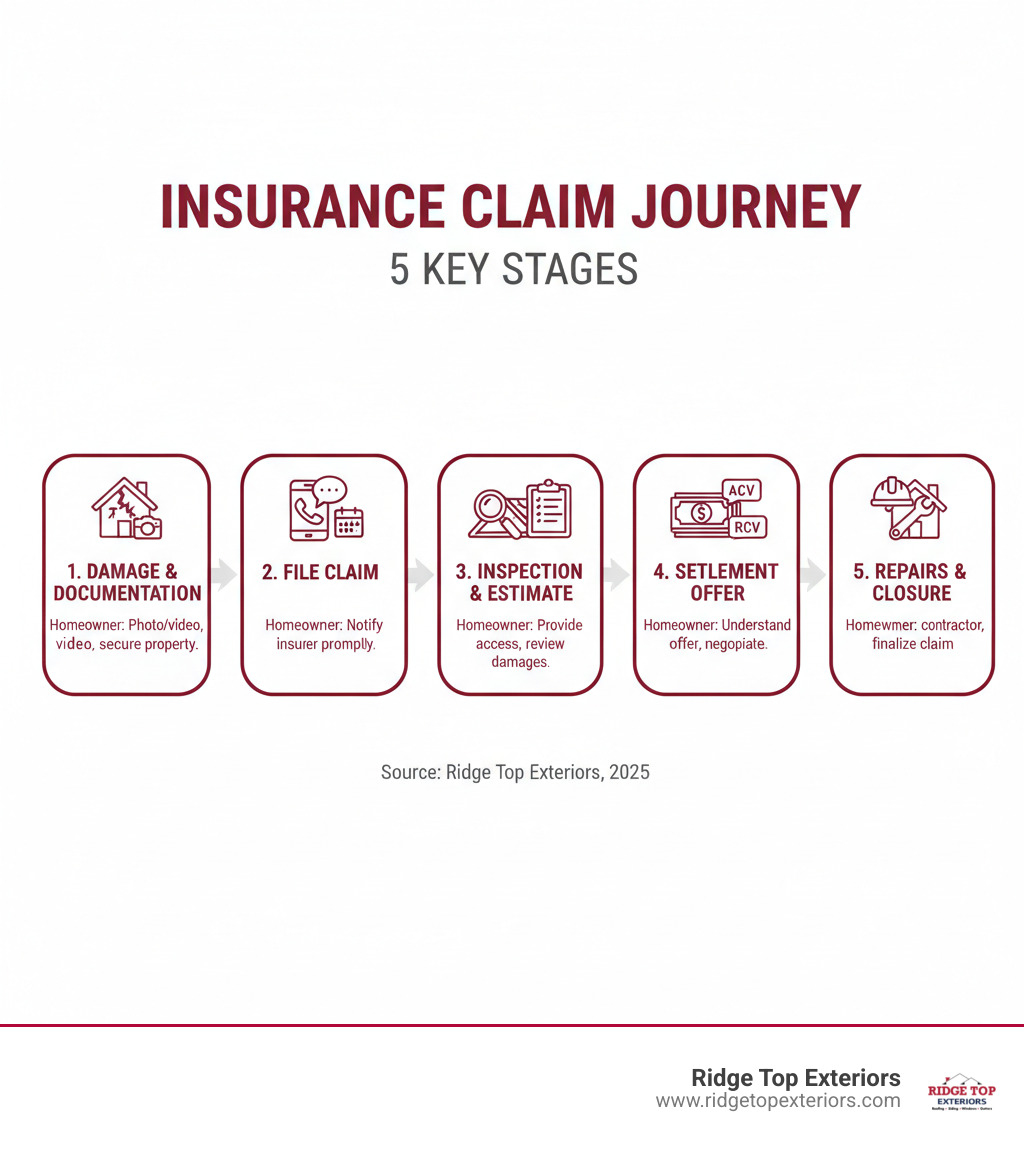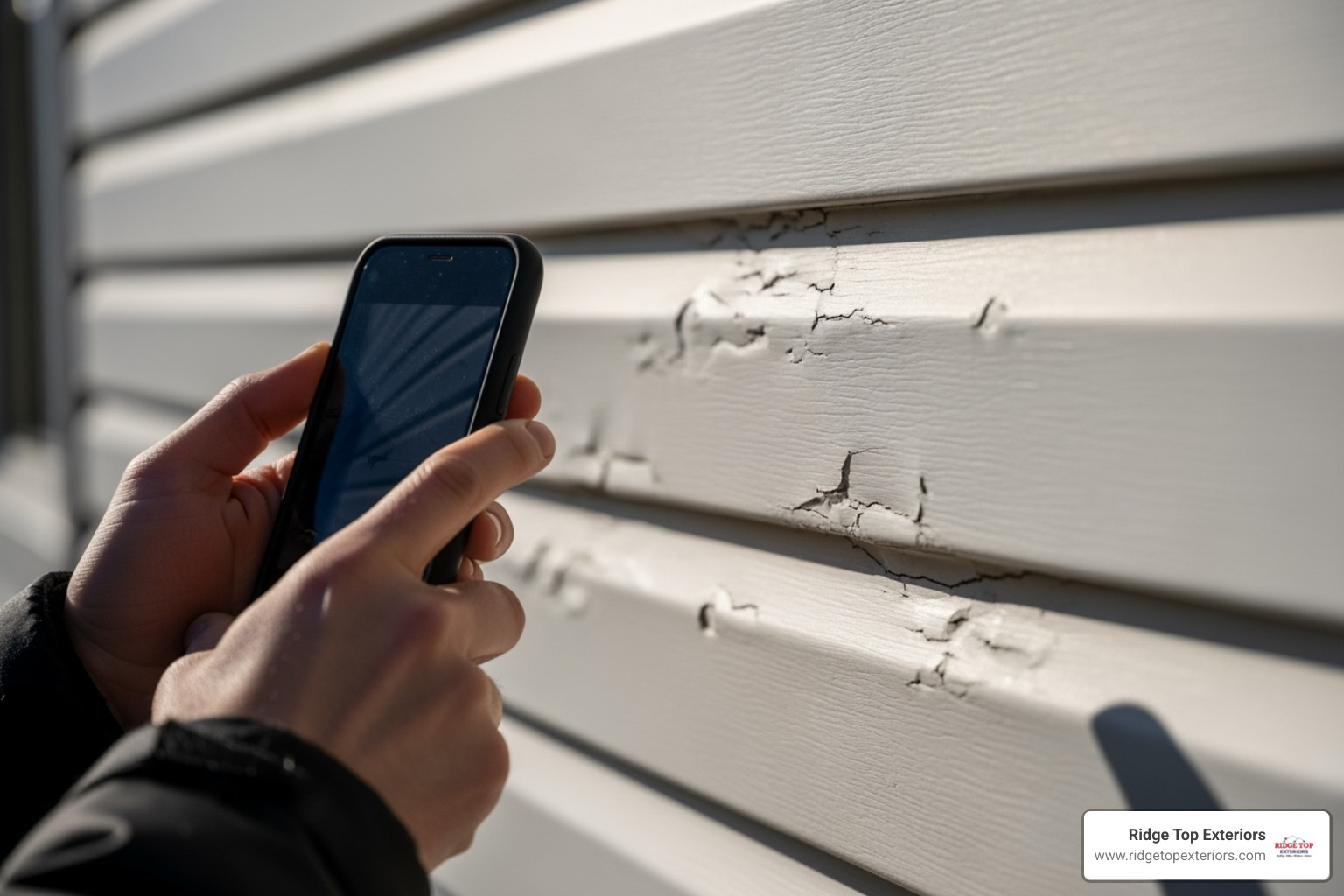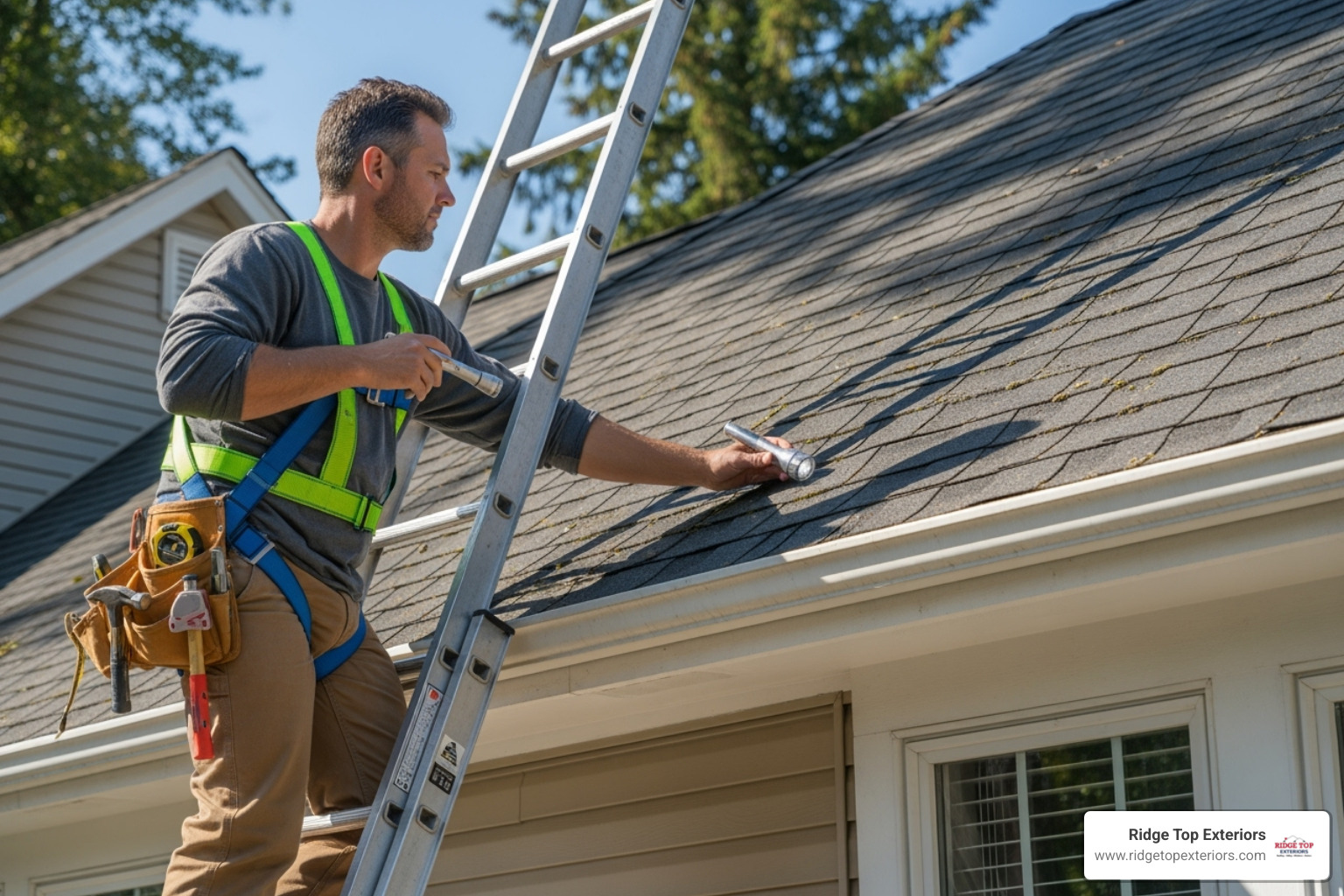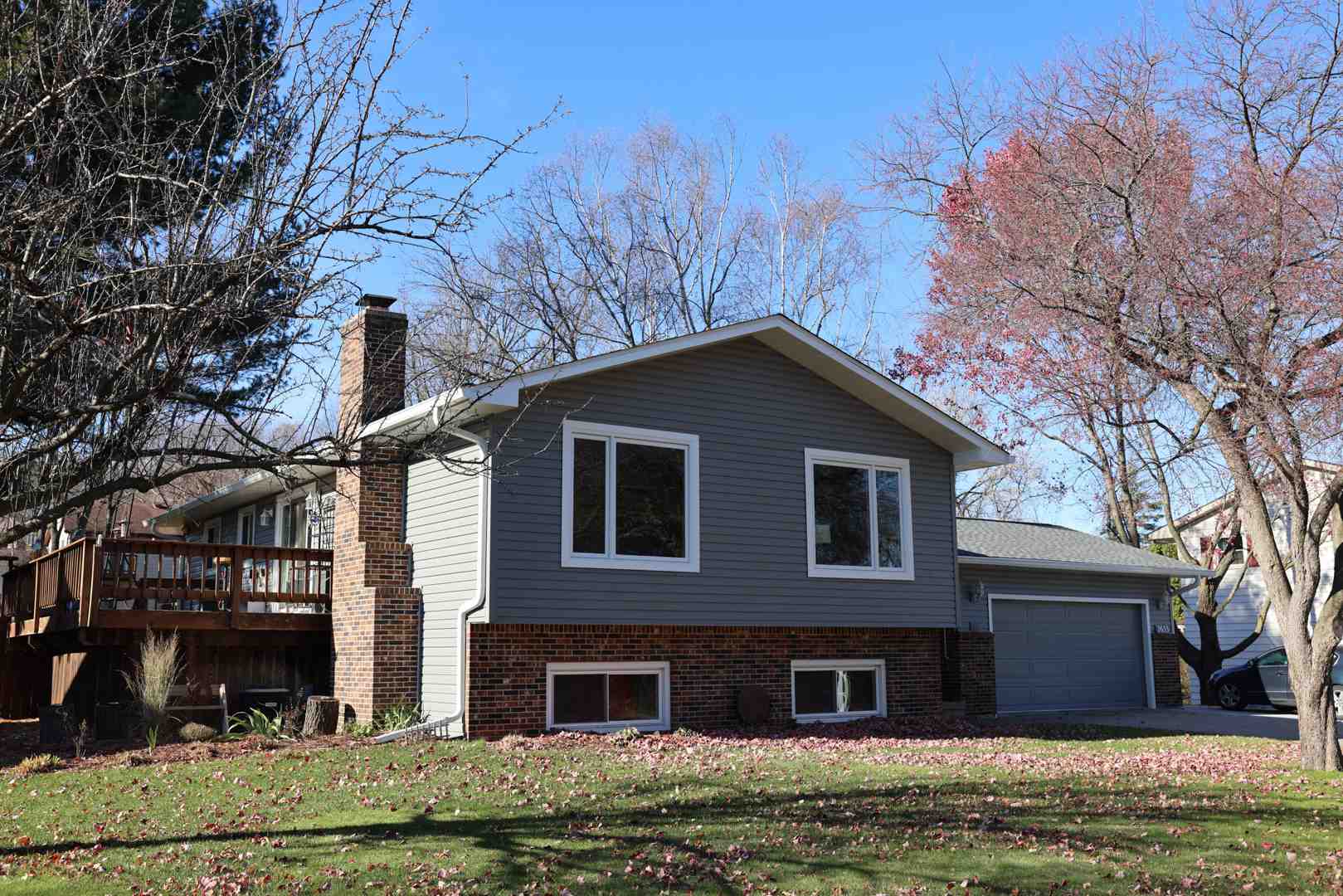
GET UP TO $200 OFF ROOFCARE+ FOR BLACK FRIDAY / CYBER MONDAY! - LEARN MORE!
Secure your fair settlement for storm damage. Get essential insurance claim help, from documenting to disputing denials.

If you need insurance claim help, here's what you need to know right away:
Dealing with storm damage is stressful enough. Fighting with your insurance company for a fair settlement shouldn't make it worse.
Getting a claim approved and paid fairly is often complex. Many homeowners are unaware of their rights and the resources available to help.
Your premiums entitle you to coverage. Understanding the basics of the claims process can mean the difference between an underpayment and a settlement that actually covers your repairs.
Insurance companies have teams of adjusters, lawyers, and claim professionals working to protect their bottom line. You deserve the same level of expertise on your side.
Whether you're dealing with roof damage from hail or siding torn off by wind, the claim process follows similar steps. The key is knowing what to document, when to push back, and who can help when things get complicated.
This guide covers the entire claim process, from initial damage to final repairs. We'll explain what to expect from adjusters, why claims are denied, and when to seek professional help.
Most disputes arise from poor documentation, misunderstandings about coverage, or homeowners not knowing their rights. We'll help you avoid these pitfalls.
I'm Carter Joyce, Director of Marketing at Ridge Top Exteriors. For over five years, I've helped homeowners in Wisconsin, Illinois, and Florida steer storm damage claims. Our team has completed over 45,000 exterior projects, many involving insurance, so we know how to document damage and work with adjusters to ensure fair settlements.

After a storm, the damage to your home can feel overwhelming. The first steps you take are critical for your entire insurance claim help process.
Your first priority is always safety. If your home has structural damage that makes it unsafe, get everyone out and contact emergency services. Don't take chances with downed power lines or gas leaks.
Once everyone is safe, you need to prevent further damage, a requirement in most insurance policies. Tarp any holes in the roof or board up broken windows to stop the situation from worsening. Keep every single receipt for these emergency repairs. Your policy typically covers these costs, but only if you can prove what you spent.
Contact your insurer as soon as the property is secure. Most policies require you to report damage promptly, and delays can give the insurance company grounds to deny your claim.
Before you call, give your insurance policy a quick read. Understanding your policy—what's covered, your deductible, and any exclusions—helps you communicate more effectively with your insurer.

Good documentation is the key to a successful claim. The more evidence you gather, the harder it is for anyone to dispute what happened.
Photo evidence is your best friend. Take wide shots for context and close-ups of specific issues like cracked shingles or dented siding. Capture multiple angles, both inside and out. Also, photograph undamaged parts of your home to create context. If your neighbor's house has similar damage, photograph that as well—it helps establish that a weather event caused the problem, not simple wear and tear.
Video walkthroughs add another layer of documentation. Walk through your property while recording and narrating what you see. This creates a narrative that photos alone can't capture.
Written notes are also important. Jot down when you first noticed the damage, the weather conditions, and any specific details you observed. These notes create a timeline that supports your claim.
For roof damage, a professional inspection can make a huge difference. A trained eye can spot issues you might miss, and a detailed report from an experienced contractor carries weight with adjusters. Learn more about The Advantages of Professional Roof Inspections and how they can strengthen your claim.
When you're ready to file your claim, having the right information ready makes the process smoother. Before you call, gather your policy number and prepare a clear summary of the incident details: what happened, when, and what damage resulted.
Understanding your deductible is crucial. This is the amount you'll pay out of pocket before insurance kicks in. If the repair cost is only slightly more than your deductible, filing a claim may not be worth it, as claims can impact your future premiums.
You have rights as a policyholder. Insurance companies are required to treat you fairly, respond to your claim promptly, and explain their decisions clearly, including any denials or settlement reductions.
The Texas Department of Insurance offers excellent Tips for filing a claim with your insurance company that apply regardless of your state.
At Ridge Top Exteriors, we've seen how proper documentation and timely filing lead to a smoother process. If you're dealing with storm damage in Wisconsin, Illinois, or Florida, we can help guide you from the initial inspection to the final repairs.
After filing your claim, the assessment and negotiation phase begins. Your insurance company will assign an adjuster to inspect your property and determine the scope of loss—what's damaged and what it will cost to fix.
We can't stress this enough: be there during the inspection. Walk through your property with the adjuster, point out everything you've documented, and share your photos. Your active participation helps ensure nothing gets missed, as adjusters are often juggling dozens of claims at once.
After the inspection, you'll receive a settlement offer. This is where understanding two key terms becomes crucial: Actual Cash Value (ACV) and Replacement Cost Value (RCV).
ACV is the value of your damaged property minus depreciation for age and wear. RCV, on the other hand, is the cost to replace it with new materials of similar quality. Most RCV policies pay the ACV amount first. The remaining amount (the depreciation) is paid after you complete the repairs and provide invoices.

Even when you've done everything right, claims can be denied or come back frustratingly low. Understanding why can help you avoid these issues or know when to push back.
If you live in an area with severe weather, understanding these nuances is vital. Our guide on Roofing Solutions for Harsh Weather Conditions can help.
Getting insurance claim help often means taking a proactive approach to protect your interests.
Don't accept the first estimate blindly. Get at least one independent estimate from a reputable contractor. Our team at Ridge Top Exteriors uses the same estimating software (like Xactimate) that most adjusters use, which makes comparisons straightforward and reduces disputes. Note: Final pricing requires a free, on-site quote, as cost varies based on size, complexity, and materials.
Make sure estimates include overhead and profit (O&P) line items—typically 10% each. These are legitimate project management costs that insurers should cover when a general contractor is involved.
Beware of "storm chasers." After major storms, out-of-state contractors may use aggressive tactics, inflate quotes, and perform shoddy work. This has been a major issue in states like Florida. Choose a local, established contractor with deep roots in your community. Ridge Top Exteriors has served Wisconsin, Illinois, and Florida since 2002, with over 45,000 completed projects.
Be cautious about cashing checks. If your insurer sends a check labeled "full and final settlement" and you disagree with the amount, cashing it might forfeit your right to dispute. It's safer to hold off until you've reached an agreement.
Finally, proper home maintenance can make future claims smoother. Check out our Best Practices for Maintaining Your Home Exterior After Storm Damage to keep your home protected.
Getting a denial letter or a settlement offer that doesn't cover your repairs is frustrating. But here's the good news: a denial or lowball offer isn't the final word. You have options, and informed homeowners who push back often get better outcomes.
The path forward typically involves a formal complaint letter, an appeal, or in some cases, mediation or arbitration. It's critical to be aware of time limits for action. Policies and state laws set deadlines for taking legal action, sometimes as little as one year from the date of denial. Missing these deadlines can permanently close the door on your claim, so act promptly.
If your claim is denied or the settlement seems unfair, your first move should be to work through your insurer's internal review process. This step is usually required before you can escalate the dispute.
Start by requesting a written explanation for the decision. Your insurer is required to tell you exactly why they denied your claim or calculated the settlement as they did, citing specific policy language. This document is crucial for your appeal and may reveal a simple misunderstanding.
Next, escalate the complaint by sending a detailed letter to your insurer's complaints department. Include your policy number, a summary of what happened, copies of all your documentation, and a firm but professional explanation of why you believe their decision is wrong. Explain what you believe the fair resolution should be.
Regulated insurers must have a written procedure for handling complaints and must respond within a reasonable timeframe, as defined by state law.
Your state insurance department exists to protect you. These consumer complaint divisions serve as a watchdog over insurance companies and can be a powerful ally when you're seeking insurance claim help.
State insurance departments provide regulatory oversight, ensuring that companies follow state laws and treat policyholders fairly. While they generally can't force an insurer to pay your specific claim, they can mediate, investigate whether your claim was handled according to state law, and review the insurer's practices for patterns of unfair treatment.
When you file a complaint, the department will contact the insurance company on your behalf for an explanation. This regulatory pressure often motivates insurers to take a second, more careful look at your claim. The department can also help you understand your policy, explain your rights, and suggest next steps.
At Ridge Top Exteriors, we've worked with countless homeowners through these disputes across Wisconsin, Illinois, and Florida. We've seen how state insurance departments can shift the conversation when a claim seems stuck. If you're hitting a wall with your insurer, reaching out to your state's department of insurance is a good next step.
When you're facing significant storm damage, it can feel like the deck is stacked against you. Insurance companies have their own experts working to protect their interests. This is where professional insurance claim help comes in, helping to level the playing field through expert policyholder advocacy.
At Ridge Top Exteriors, we work closely with Insurance Professionals to help our clients in Wisconsin, Illinois, and Florida get fair outcomes. We've seen how the right professional support can transform a frustrating experience.

It's vital to understand the difference between these two types of adjusters. A public adjuster works for you, the policyholder, to assess your damage and negotiate with your insurer. A company adjuster or independent adjuster works for the insurance company. Their incentives differ: the company adjuster works to minimize the insurer's payout, while the public adjuster works to maximize your settlement.
Consider hiring a public adjuster for large or complex claims, denied claims, or lowball offers. They are also helpful if you simply don't have the time or expertise to manage the process. Public adjusters typically charge a percentage of your final settlement (often 5-15%), but they frequently secure settlements high enough to more than cover their fee.
You can find qualified public adjusters through the National Association of Public Insurance Adjusters at NAPIA.
Most claims don't require an attorney, but there are situations where legal help is necessary to protect your rights.
One key reason is a bad faith claim. This may occur if your insurer unreasonably delays or denies your claim, or offers a settlement that's clearly inadequate. An attorney can hold them accountable for not handling your claim fairly.
You should also consider legal representation for complex liability issues or disputes over policy interpretation, such as disagreements over exclusions or the cause of damage. Most insurance attorneys work on a contingency basis, meaning they only get paid if you win your case. They will review your policy, negotiate with the insurer, and file a lawsuit if needed.
A reputable contractor can be one of your most valuable allies in the insurance claim process. Choosing the right one can make the difference between a smooth claim and a nightmare.
A qualified contractor provides expert damage assessment. Our team at Ridge Top Exteriors has inspected thousands of storm-damaged homes. We know how to identify and document storm damage versus normal wear on roofing, siding, and windows in a way that adjusters respect.
We also provide detailed estimates using industry software like Xactimate, the same program adjusters use. This creates a clear, apples-to-apples comparison and reduces disputes over costs.
Perhaps most importantly, experienced contractors know how to work effectively with insurance adjusters. We can attend adjuster meetings, point out missed damage, and provide professional opinions that carry weight, helping to justify your claim.
Be wary of "storm chasers" who may perform substandard work. That's why choosing a local, established contractor with a proven track record is so important. Ridge Top Exteriors has been serving communities in Wisconsin, Illinois, and Florida since 2002. Our thousands of five-star reviews and factory certifications from manufacturers like GAF speak to our commitment to quality and integrity. Our guide on How to Choose the Right Roofing Contractor provides more detailed advice.
The bottom line is this: you don't have to steer the insurance claim process alone. Professional insurance claim help from a public adjuster, attorney, or qualified contractor can ensure a fair outcome. The key is knowing when to get help and choosing professionals who have your best interests at heart.
Get your free consultation today!

Upgrade your home with expert Window replacement Verona WI. Boost energy efficiency, comfort, and value. Get a free estimate!
Read More
Upgrade your Milwaukee home! Get expert replacement windows Milwaukee services for energy savings, comfort, and curb appeal. Free quote!
Read More
Considering window replacement Appleton WI? Learn signs, benefits, options, costs, and find your perfect local installer.
Read More